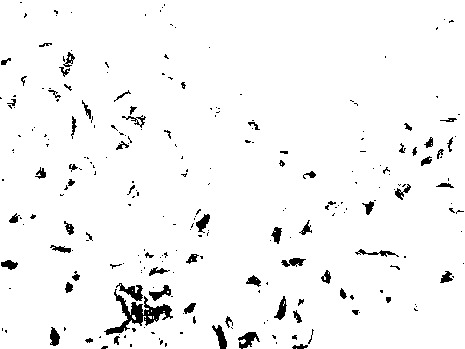Astrocyte separating and cultivating method
An astrocyte and culture method technology, which is applied in the field of in vitro separation and culture of astrocytes, can solve the problems of few passages, cell contamination, difficult separation of fibroblast hybrid cells, etc., and achieves short operation time, Low cost of reagents and the effect of promoting cell adhesion
- Summary
- Abstract
- Description
- Claims
- Application Information
AI Technical Summary
Problems solved by technology
Method used
Image
Examples
Embodiment 1
[0025] Example 1: Isolation and culture of rat astrocytes
[0026] Experimental animals: SD1-2 newborn 1-3 days old (provided by the Experimental Animal Center of Xiangya School of Medicine, Central South University), male or female.
[0027] Main reagents and instruments: DMEM (Hyclone Company), trypsin (Ameresco Company), newborn bovine serum (Hangzhou Sijiqing Company), rabbit anti-GFAP polyclonal antibody (Sigma Company), goat anti-rabbit IgG kit (Vector Company), D-Hank's solution (homemade according to recipe), rat tail collagen (homemade), CO 2 Incubator (FormaScientific Company), inverted microscope (Olympus Company).
[0028]Primary culture: take newborn SD suckling mice 1 to 3 days old, soak the skin in 75% ethanol for 5 to 10 minutes to disinfect the skin, decapitate, carefully cut the skull with ophthalmic scissors under sterile conditions, and then take out both sides with ophthalmic forceps Place the cerebral cortex in a petri dish filled with D-Hank's solution...
Embodiment 2
[0036] Example 2: Isolation and culture of astrocytes from other animals
[0037] Experiments have proved that this method can be used for the cultivation of relatively fragile tissues such as fetal rats, newborn (1-3 days after birth) rats, mice, and guinea pigs, especially astrocytes in the cerebral cortex, and the experimental protocol is the same as above. But for adult humans, it is difficult to achieve the goal with this method because the cerebral cortex tissue is relatively tough. However, experiments have shown that the same effect can be achieved by using this method to obtain the cerebral cortex tissue of induced fetuses. The gestational age of 5 months is the most suitable, and the experimental results will be affected if the gestational age is too small or too large. The purity of the astrocytes isolated and cultured by the method is over 95%.
PUM
| Property | Measurement | Unit |
|---|---|---|
| pore size | aaaaa | aaaaa |
| purity | aaaaa | aaaaa |
Abstract
Description
Claims
Application Information
 Login to View More
Login to View More - R&D
- Intellectual Property
- Life Sciences
- Materials
- Tech Scout
- Unparalleled Data Quality
- Higher Quality Content
- 60% Fewer Hallucinations
Browse by: Latest US Patents, China's latest patents, Technical Efficacy Thesaurus, Application Domain, Technology Topic, Popular Technical Reports.
© 2025 PatSnap. All rights reserved.Legal|Privacy policy|Modern Slavery Act Transparency Statement|Sitemap|About US| Contact US: help@patsnap.com


